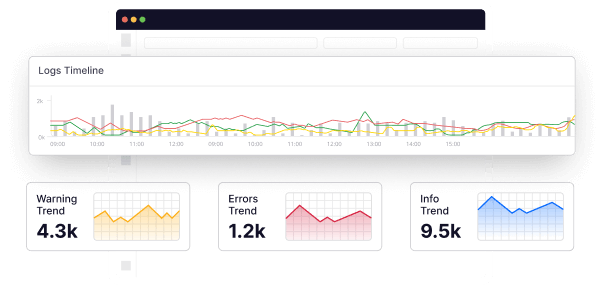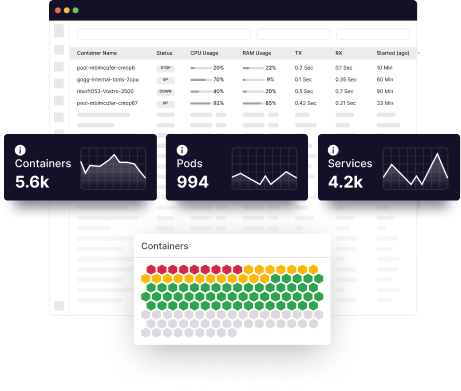The digital database has come a long way since its inception in the 1960s. Modern databases now serve as sophisticated storehouses for both unstructured and structured data, and they play a vital role in businesses’ day-to-day operations. With this rising complexity, so does the need to have Database monitoring software!
In this article, we’ll delve into the world of database monitoring, exploring what it is, why it’s crucial, and how it works and explore top 5 Database monitoring software.
What Is Database Monitoring?
Database monitoring is a practice that enables companies to keep a close eye on their network and database performance. It encompasses a set of specific tasks performed regularly to ensure that a database operates optimally.
This includes both hardware and software maintenance. Think of it as an ongoing health check-up for your data management system (DMS).
Why is Database Monitoring Important?
While databases have been around for decades, they remain an integral part of today’s business landscape. Neglecting their health can lead to substantial revenue losses. In 2014, a Gartner study estimated downtime costs at an average of $5,600 per minute.
Today, studies estimate downtime at around $9,000 per minute, with larger organizations facing hundreds of thousands per hour.
Database monitoring ensures the scalability, customization, and compliance of data management systems, enabling businesses to:
- Avoid revenue losses.
- Safeguard sensitive data.
- Provide a better user experience.
- Analyze data more effectively.
- Reduce IT infrastructure costs.
- Automate time-consuming tasks.
- Create an iterative process for continuous improvement
In a world where DevOps is rapidly evolving, and hybrid databases are becoming the norm, effective database monitoring is essential. It enables organizations to navigate the complexity of their expanding IT landscapes with ease, increasing operational efficiency.
Database administrators no longer need to manually track performance or rely on insufficient monitoring tools. Database monitoring systems provide real-time alerts and identify issues quickly. They not only save time but also help prevent catastrophic failures and performance bottlenecks.
How To Choose The Right Database Monitoring Tool
Today, it is a common scenario: Even robust global enterprises in retail, e-commerce, and telecommunications are vulnerable to sudden database outages that can paralyze operations for hours and cost millions in revenue.
Such incidents serve as a stark reminder that, regardless of a company’s size or resources, maintaining a resilient database is imperative.
To get started with database monitoring, IT teams need to select a suitable platform and acquaint themselves with its functionalities.
A multitude of available options, ranging from tools addressing singular system components to all-encompassing solutions, presents a potentially overwhelming decision-making process.
To streamline this, focus must be on specific considerations.
- Identify the components requiring monitoring, whether involving the network, server, or application.
- Define the essential data that needs collection and correlation to effectively manage and optimize the system.
- Determine the monitoring objective, whether observing patterns over time or necessitating real-time alerts for critical issues.
- Assess the required level of support for the organization and the allocated budget for implementing the monitoring solution.
- Finally, establish whether the monitoring will focus on on-premises systems (such as MySQL, MariaDB, PostgreSQL, or Microsoft SQL Server), cloud environments (including Microsoft Azure, Amazon RDS, Google Cloud, AWS, Amazon Aurora, or Oracle Cloud), or both.
By considering these factors, IT teams can narrow down the options and find the most suitable database monitoring tool to meet their specific operational needs.
Top 5 Database Monitoring Software
Effectively managing and optimizing databases requires the selection of appropriate monitoring software, which is pivotal. A wide array of database monitoring systems exists, each offering unique features and capabilities to ensure the health and efficiency of your databases.
Here’s an overview of the top five database monitoring software options that offer a range of features, benefits, and considerations.
Middleware
Middleware’s Database Monitoring Software is an all-encompassing tool that provides detailed insights into the health and performance of multiple databases, supporting optimization and issue resolution.

Key Features
- Monitoring query metrics like average latency, execution time, and rows queried.
- Identifying and monitoring changes in the database through automatic query monitoring.
- Quick issue identification and reducing Mean Time to Repair (MTTR) through troubleshooting and root cause analysis.
- Providing both immediate and long-term query performance tracking with real-time and historical performance insights.
- Supporting various databases, both relational (Oracle, MSSQL, MySQL, PostgreSQL) and NoSQL (MongoDB, Cassandra, Couchbase).
Pros
- Comprehensive monitoring of various database aspects.
- Proactive query tracking and anomaly alerting.
- Wide coverage of relational and NoSQL databases.
- Timely monitoring and correlation for performance optimization.
Cons
Middleware is relatively new to the market and might lack a certain level of maturity or specific functionalities compared to more established solutions.
Pricing
- Free Forever Developer Account.
- Tailored Paid Plans based on customized, usage-based models.
Get Started with Middleware’s Database Monitoring for free!
Datadog
Datadog offers a unified monitoring and analytics platform that provides comprehensive visibility into database performance. It supports various database technologies, including MySQL, PostgreSQL, Oracle Database, MongoDB, and Amazon RDS.
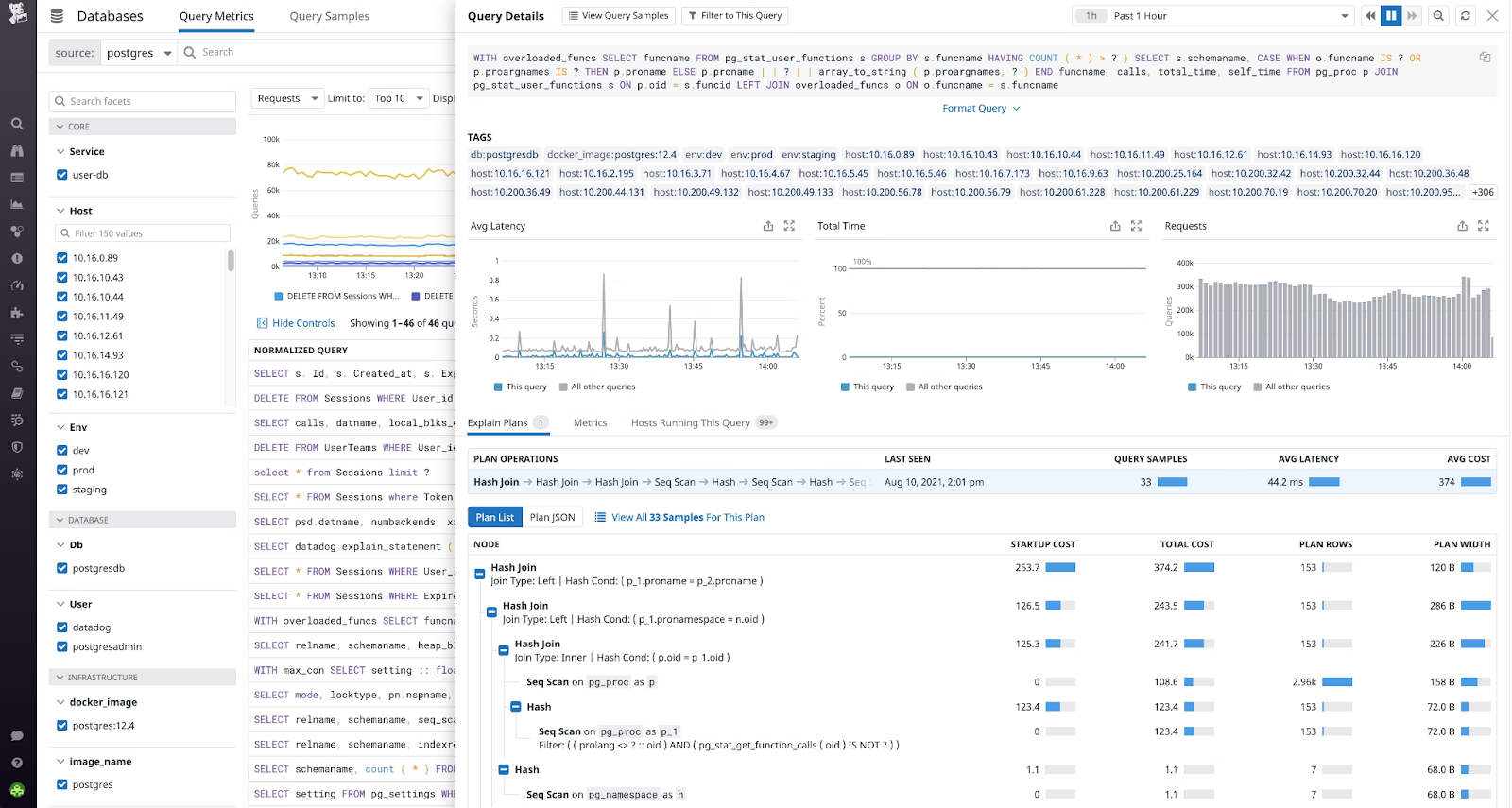
Key Features
- Real-time monitoring of database performance metrics.
- Historical data analysis for trend identification.
- Root cause analysis tools for quick issue resolution.
- Customizable alerts and notifications.
- Integrations with other monitoring tools and cloud platforms.
Pros
- Comprehensive monitoring of major database technologies.
- Powerful analytics and reporting capabilities.
- User-friendly interface.
- Scalable for large and complex database environments.
Cons
- Potential cost challenges for large enterprises.
- Reports of performance issues by some users.
Pricing
Free trial available with paid plans starting at $15 per month per host.
Site24x7
Site24x7 is a cloud-based database monitoring platform offering visibility into database performance and availability, supporting various database technologies.
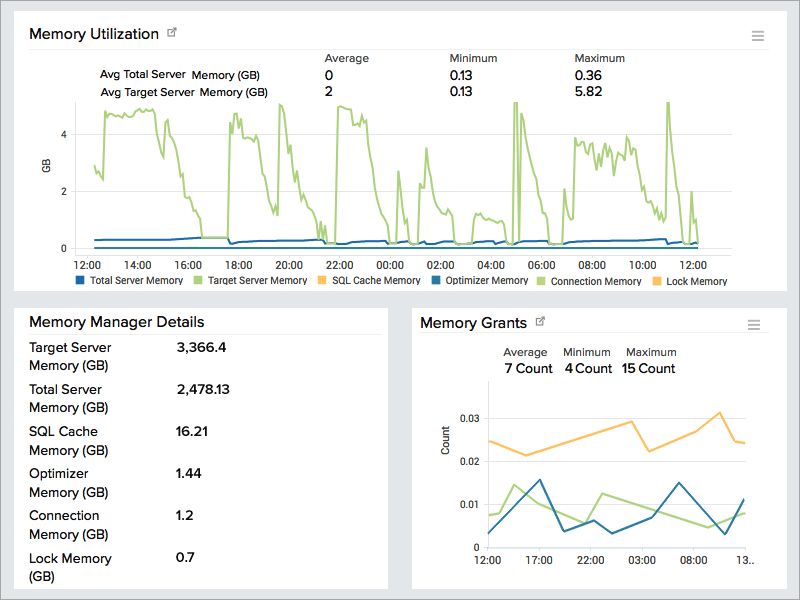
Key Features
- Real-time monitoring of database performance metrics.
- Historical data analysis for trend identification.
- Root cause analysis tools for quick issue resolution.
- Customizable alerts and notifications.
- Integrations with other monitoring tools and cloud platforms.
Pros
- Affordable pricing.
- Comprehensive monitoring of major database technologies.
- User-friendly interface.
- Good customer support.
Cons
- Some limitations in scalability compared to other solutions.
- Reports of performance issues by some users.
Pricing
Free plan available with paid plans starting at $9 per month per monitor.
MySQL Enterprise Monitor
MySQL Enterprise Monitor by Oracle is a commercial solution specifically designed for monitoring MySQL databases, offering comprehensive visibility into their performance, availability, and security.
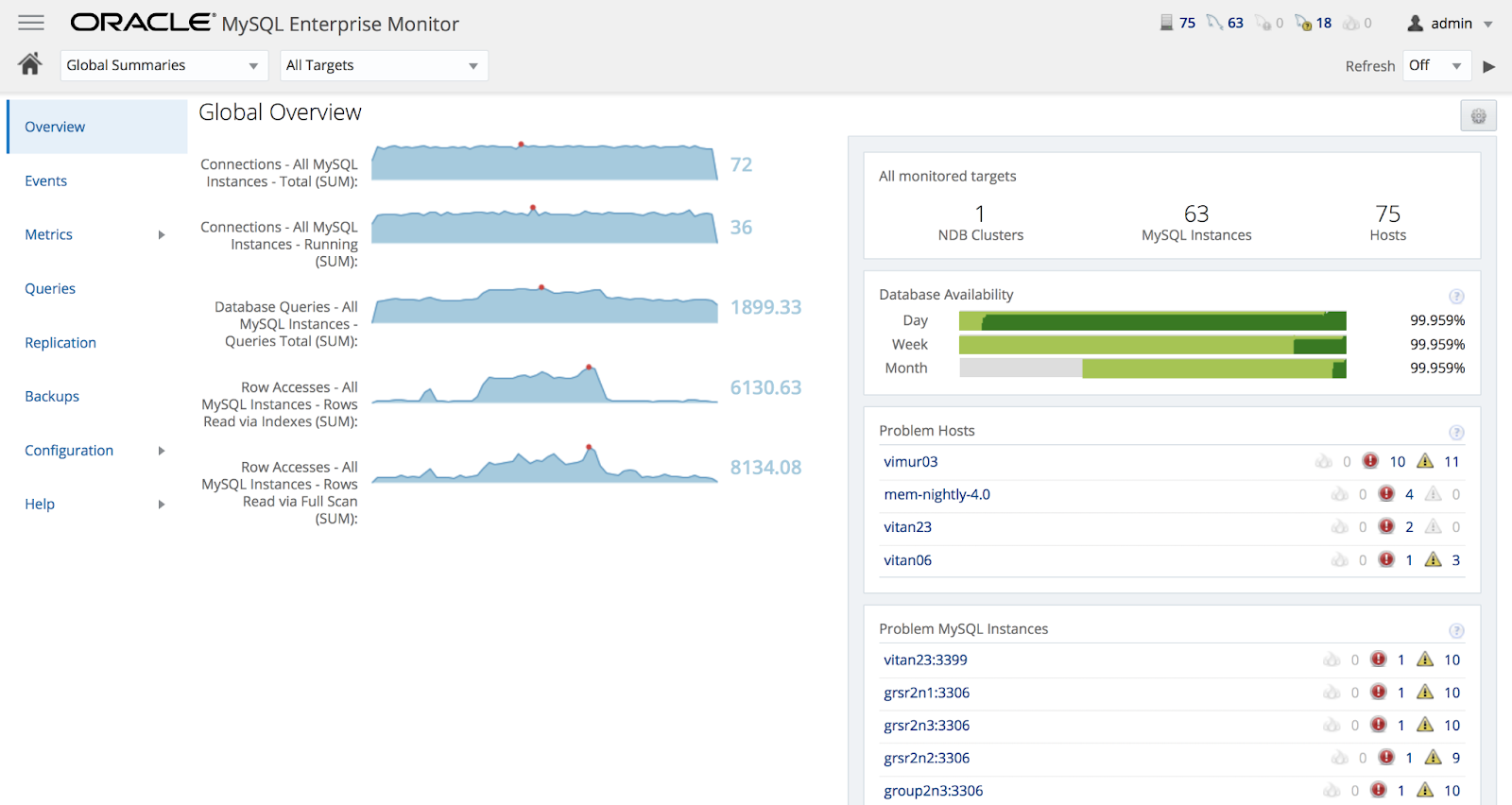
Key Features
- Real-time monitoring of database performance metrics.
- Historical data analysis for trend identification.
- Root cause analysis tools for quick issue resolution.
- Customizable alerts and notifications.
- Integrations with other monitoring tools and cloud platforms.
Pros
- Comprehensive monitoring of MySQL databases.
- Powerful analytics and reporting capabilities.
- User-friendly interface.
- Scalable for large and complex database environments.
Cons
- Cost may be a concern.
- Limited to supporting MySQL databases only.
Pricing
Available upon request.
Oracle Enterprise Manager
Oracle Enterprise Manager is an enterprise management solution inclusive of database monitoring capabilities supporting various database technologies.
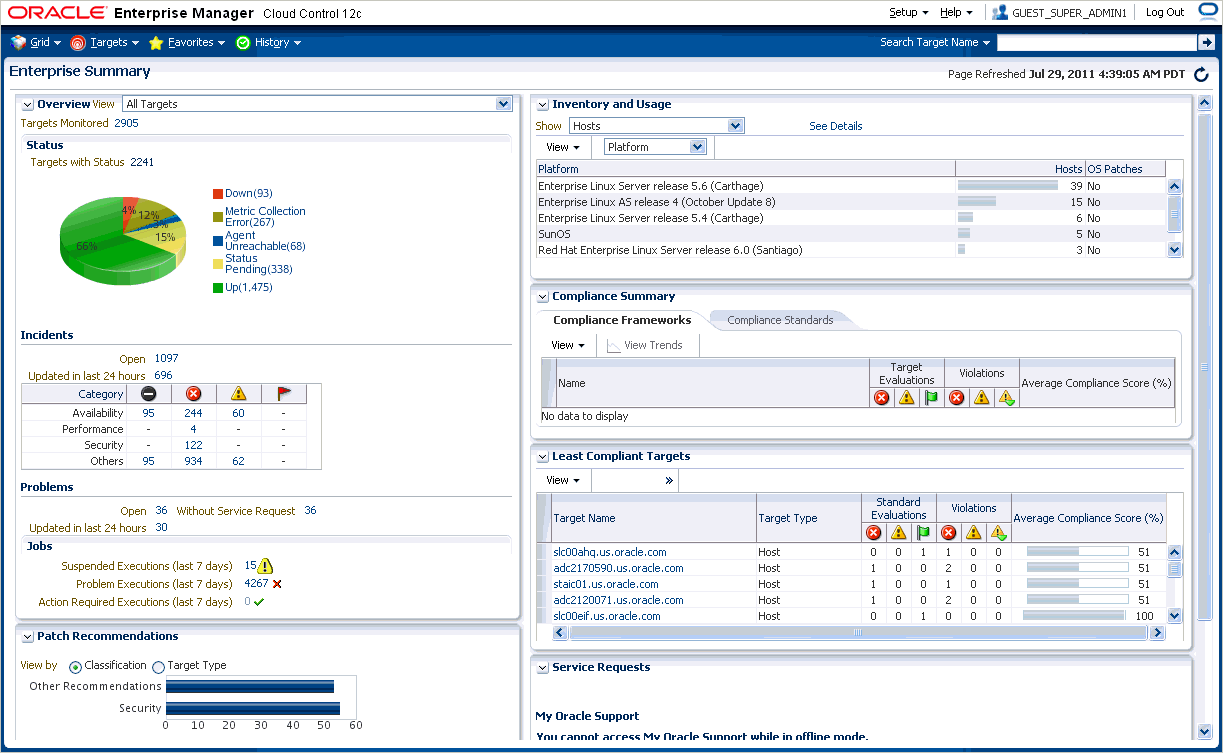
Key Features
- Real-time monitoring of database performance metrics.
- Historical data analysis for trend identification.
- Root cause analysis tools for quick issue resolution.
- Customizable alerts and notifications.
- Integrations with other monitoring tools and cloud platforms.
Pros
- Comprehensive monitoring of major database technologies.
- Powerful analytics and reporting capabilities.
- User-friendly interface.
- Scalable for large and complex database environments.
Cons
- Potential complexity in configuration and usage.
- Cost considerations.
Pricing
Available upon request.
Benefits Of Using Database Monitoring Software
Database monitoring software can have several benefits, including:
Better Resource Availability and Consumption
Databases monitoring software regularly scanners Databases to ensure they are online, both during and after standard working hours. The system constantly monitors resources like CPU and other network components, sending alerts to relevant team members in case of issues.
Tracking Throughput
This type of monitoring includes aspects like replication latency. Benchmarks are set and compared to current figures, making it easy to spot and investigate deviations from the norm.
Log Tracking
Database logs play a crucial role in monitoring, providing essential information about running queries and their execution times. Different types of database logs capture information that isn’t typically trackable with standard performance metrics.
As businesses continue to accumulate vast amounts of data, data management techniques must evolve to keep pace. Built-in data management systems can increase server loads and lead to unnecessary data bloat, impacting accessibility for administrators.
According to recent market data, the global database monitoring software market is on a significant growth trajectory. In 2022, it was valued at USD 1.79 billion, and projections indicate it will reach USD 5.61 billion by 2030, with a compound annual growth rate (CAGR) of 15.5%.
These tools not only enhance security but also ensure that business-critical applications always function optimally, avoiding inconveniences for end-users.
Challenges in Database Monitoring
Database monitoring presents a series of challenges for administrators. Within multi-tier applications, the performance of databases stands as a crucial determinant for overall application efficiency. When databases underperform, applications suffer, potentially leading to a poor user experience and revenue loss.
The array of database systems available introduces multifaceted obstacles for administrators. These systems have evolved, incorporating technologies such as in-memory caching and optimized indexing, making it challenging to pinpoint the source of performance issues.
Moreover, the increasing adoption of virtualization and cloud computing for database servers adds another layer of complexity. Administrators often face the daunting task of determining whether a slowdown is due to the database server, the hosting virtual machine, or the underlying storage platform.
Forecasting the Future of Database Monitoring Software
The future of database monitoring software appears incredibly promising, poised for significant growth in the coming years. This projection is underpinned by several driving forces, including the expanding reliance of businesses on databases, the increasing complexity of database systems, and the imperative need to monitor databases for optimal performance, security, and compliance.
Moreover, key trends are anticipated to shape the trajectory of database monitoring software:
Cloud Computing and Multi-cloud Environments: As businesses progressively migrate their databases to the cloud, the demand for database monitoring software adept in supporting cloud-based and multi-cloud environments is expected to surge.
Adoption of AI and ML: The integration of AI and ML in database monitoring software will revolutionize its capabilities, allowing for more intelligent and proactive problem detection, diagnosis, and prediction.
Emphasis on Data Security and Compliance: Database monitoring software will remain indispensable for ensuring the security and compliance of databases, aligning with relevant regulations.
With these trends in mind, the demand for database monitoring software is projected to sustain its growth momentum in the forthcoming years.
In this rapidly evolving landscape, the choice of a comprehensive, proactive, and adaptable database monitoring solution is pivotal. Middleware’s Database Monitoring Software offers a compelling proposition.
With its proactive approach, extensive support for diverse databases (both relational and NoSQL), and the ability to identify issues swiftly while offering real-time insights, Middleware stands out as an ideal option for businesses aiming to optimize their databases efficiently.
Conclusion
Choosing the right database monitoring software depends on the specific needs and budget of the organization. Each solution has its strengths and limitations, and evaluating them based on the unique requirements is crucial for making an informed decision.
By employing these software solutions, businesses can efficiently maintain and optimize their databases, ensuring smooth operations and facilitating quick issue resolution, ultimately contributing to enhanced productivity and performance.


